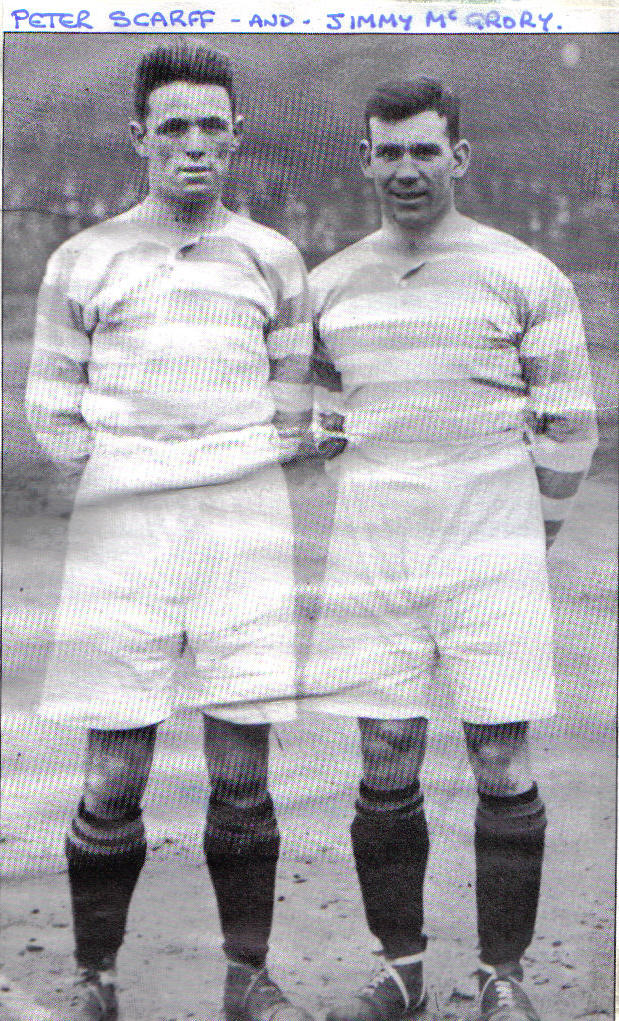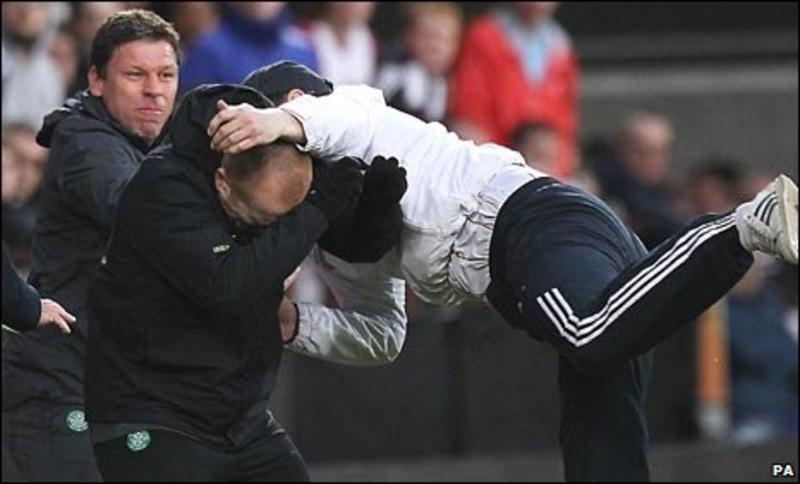Broken hearts would become a feature at Celtic Park in the decade to follow the North American tour.

In the aftermath of John Thomson’s tragic death at Ibrox on 5 September 1931, Willie Hughes would be reintroduced to the grief-stricken Celtic side, replacing Jimmy McGrory as attacking spearhead a fortnight later, opening the scoring then gaining a penalty, which Charlie Napier converted, in the 3-3 draw with Morton at Cappielow. John Falconer had the horrendous task of replacing the spirit of The Prince in the visiting goal, as he had in making his debut the previous Saturday, against Queen’s Park, perhaps the saddest introduction ever to the Celtic first team, in the 2-2 draw at a silent Parkhead. The youngster would do his bit by saving a spot kick, which would ultimately win a point in Greenock.
This was previously covered on The Celtic Star article in my article of 5 September 2018, ‘A familiar face was missing…’?

Falconer would actually face Rangers three times in his first seven games for the club, within a month of his debut, fracturing his finger during the last of those, on Wednesday, 7 October 1931.
John had excelled in a nine-year career at Cowdenbeath, once saving three penalties at Easter Road then another from Everton great, Dixie Dean, whilst representing the Scottish League against their English equivalents at Ibrox, in 1928.
Later that year, Falconer suffered a broken kneecap at Tynecastle, which effectively ended his career in Fife. He had only signed for Celtic on 15 August 1931, three weeks before the death of John Thomson, thrust into a limelight he would no doubt rather have avoided.
With the arrival of Joe Kennaway in October 1931, his opportunities would be few and far between, a home defeat by Partick Thistle in November then a three-game winning run in January 1932, the highlight of his Celtic career, would be his final outings for the club. He would remain as an unused deputy for Kennaway until the end of the following season, before being released in spring 1933.
Willie Hughes had not featured in the Celtic sides which beat Falkirk 4-1, a return to Parkhead for the peerless Patsy Gallacher, five years after his acrimonious departure from the club, then drew 1-1 with Rangers at the same venue in the semi-final of the Glasgow Cup, Sam English winning a penalty for the visitors after an innocuous challenge from Peter McGonagle, Marshall converting for the equaliser.
October 1931 would commence with Willie on the left-wing for the 3-2 victory at Kilmarnock then at left-half for the visit to Ibrox for the Glasgow Cup semi-final replay three days later, Tuesday, 6 October 1931, just one month after John’s fatality at the same ground. A miskick by Rangers centre-half, Jimmy Simpson, allowed Jimmy McGrory to score a last-minute equaliser, the game finishing 2-2.
Simpson had moved to Ibrox from Dundee United in 1927, following the Tannadice club’s relegation from the top-flight, perhaps briefly crossing paths with Jack Qusklay, who arrived on Tayside the same year. He would then go on to play around 300 times for Rangers, winning fourteen Scotland caps in the process. It seems poignant that Jimmy Simpson would have played in the match on 5 September 1931, when the Celtic goalkeeper lost his life, when you consider that his son would go on to become a Parkhead legend between the sticks. Jimmy was ‘Faither’s Faither’, the dad of Lisbon Lion Ronnie, my first hero. God bless him.

Simpson senior would enjoy more luck the following night at the same venue, Rangers having won the toss for choice of grounds, a first-half header from Jimmy Smith (remember him?), deciding the second replay, the Ibrox defender earning praise in the press for his effective marking job on Jimmy McGrory.

Willie Hughes had been moved across to right-half three days later, Saturday, 10 October 1931, when he scored Celtic’s goal in the 1-1 draw with Clyde at Parkhead, 19-year-old Joe Coen the latest man to play between the sticks for the Bhoys, with broken-finger victim, John Falconer, on the sidelines and new signing, Joe Kennaway, still making his way from Canada.
Signed from Clydebank, Joe Coen would manage just three appearances for Celtic before being released at the end of the season. He would eventually become first-choice at Luton Town but sadly, just like John Thomson, he would be taken far too soon. Joe was killed in an air accident in October 1941, whilst training to be a fighter pilot, still several weeks short of his thirtieth birthday. Rest in peace, Joe.
Utility-man Hughes was then shifted across to left wing-half the following Saturday, for the 2-0 defeat at Dens Park, McGrory again struggling to free himself from the shackles of a future Ibrox icon, Dundee centre-half, Scot Symon. He would play in the Rangers team of the late thirties with Jimmy Simpson, later winning fifteen trophies as their manager in the fifties and sixties.
In the debit column, Symon would oversee two of the Ibrox club’s greatest humiliations, the 7-1 Hampden in the Sun defeat by Celtic, in the League Cup Final of October 1957, and the shock Scottish Cup defeat at Berwick, almost a decade later, having become the first Rangers manager to suffer from comparisons with Jock Stein. Nevertheless, it was still a shock when Scot Symon was sacked as Rangers manager in November 1967, replaced by the young Clyde boss David White, at a time when the Govan club were top of the table.

Willie was replaced by Peter Scarff in the side for the visit of Ayr United, on Saturday, 24 October 1931. Unbeknown at that time, this would be a significant and ultimately sad day for the incoming Celt. A double from outside-left Joe McGhee and goals from Jimmy McGrory and Charlie Napier had helped the Hoops to a 4-2 victory, although Peter had not lasted the ninety minutes, withdrawn early as he was struggling to breathe. He would continue to turn out for his beloved Hoops over the coming weeks, however, following the 6-0 home victory over Leith Athletic on Saturday, 19 December 1931, he coughed up blood after the game, Peter later diagnosed as suffering from pulmonary tuberculosis. He would never play again.
After battling the illness formerly known as consumption for two years, he passed away on 9 December 1933, just 25 years old, Willie Maley placing a Celtic jersey on his coffin. A Peter Scarff CSC was established in his honour in his birthplace, Linwood, in 1947. It runs to this day.

Both Hughes and Scarff would be accommodated in the team which faced League leaders Motherwell at Fir Park on Hallowe’en, 1931. This would mark the Hoops debut of Joe Kennoway, the game ending 2-2, with Charlie Napier grabbing a brace. Willie Hughes would then face a two-month spell on the sidelines, his next appearance coming on Boxing Day, as a Celtic side minus the struggling Peter Scarff ended the club’s own annus horribilis of 1931 with a shock 1-0 defeat by Dundee United at Tannadice.
Willie Hughes would feature in seven of Celtic’s first eight games of 1932, defeats to Rangers, Hamilton Academical and Falkirk ending any remaining hopes of clinching a first league title in six years, the Ibrox club and Motherwell left to fight it out for the flag, a race the Steelmen would ultimately win. He did manage to score in the 2-0 victory over Aberdeen at Parkhead on Saturday, 9 January 1932, however, his goal that day was dwarved by the eight he notched five days earlier at the same venue, as a Celtic and Falkirk Select beat a Scottish League eleven 10-7 in a testimonial for Patsy Gallacher. Almost four years to the day, the great McGrory, for whom Hughes often deputised, would repeat his feat in a 9-0 League victory over Dunfermline Athletic on that same Parkhead pitch, to create history.
Hughes would make ten appearances in the following campaign, four of those in the ultimately-successful Scottish Cup run, which would end with a second victory over Motherwell at Hampden in just three seasons, thanks to a goal from Guess Who. A 4-2 League defeat by the Steelmen at Fir Park in March, all four scored by the prolific McFadyen, had seen Willie’s best run in the team end at seven, albeit he did feature in the final League match of the season, a 3-0 defeat at Dens Park. Uniquely, for Willie, all of his appearances had been at left-half. On the flipside, he had failed to score a single goal.

Season 1933/34 would prove to be the pinnacle of Willie Hughes’ career at Celtic Park. He was a virtual ever-present in the side, making 41 appearances in all, mostly at left-half, albeit scoring his solitary goal that season, against Airdrieonians in December, during a brief spell back on the left wing.
During that summer, another chapter of his unique story would unfold, as he married his sweetheart, Bride Kelly, daughter of James, Celtic’s first superstar and chairman of the club until his death two years earlier, and sister of Bob, the current Parkhead director and future supremo.
Back on the field, Hughes remained a fixture in the side as the ‘34/35 campaign began, scoring Celtic’s equaliser in the 1-1 draw with Rangers at Parkhead in September, until a 2-1 defeat by Albion Rovers at Cliftonhill, at the end of that month, following which young George Paterson would make that position his own. Willie would only appear in three meaningless games in April, as a deputy for Charlie Napier, all of which Celts won.
Hughes would make just five further appearances for Celtic, in three different positions of course, over the next two seasons. On Saturday, 28 December 1935, after eight months on the sidelines, he was one of two changes in the Celtic eleven chosen to face Hamilton Academical at Douglas Park. Willie replaced Jimmy McGrory, the great man having, presumably, suffered an injury during his record-breaking hat-trick performance in the previous week’s 5-3 victory over Aberdeen at Celtic Park, as featured in the previous part of this story.

Continue reading on the next page…



